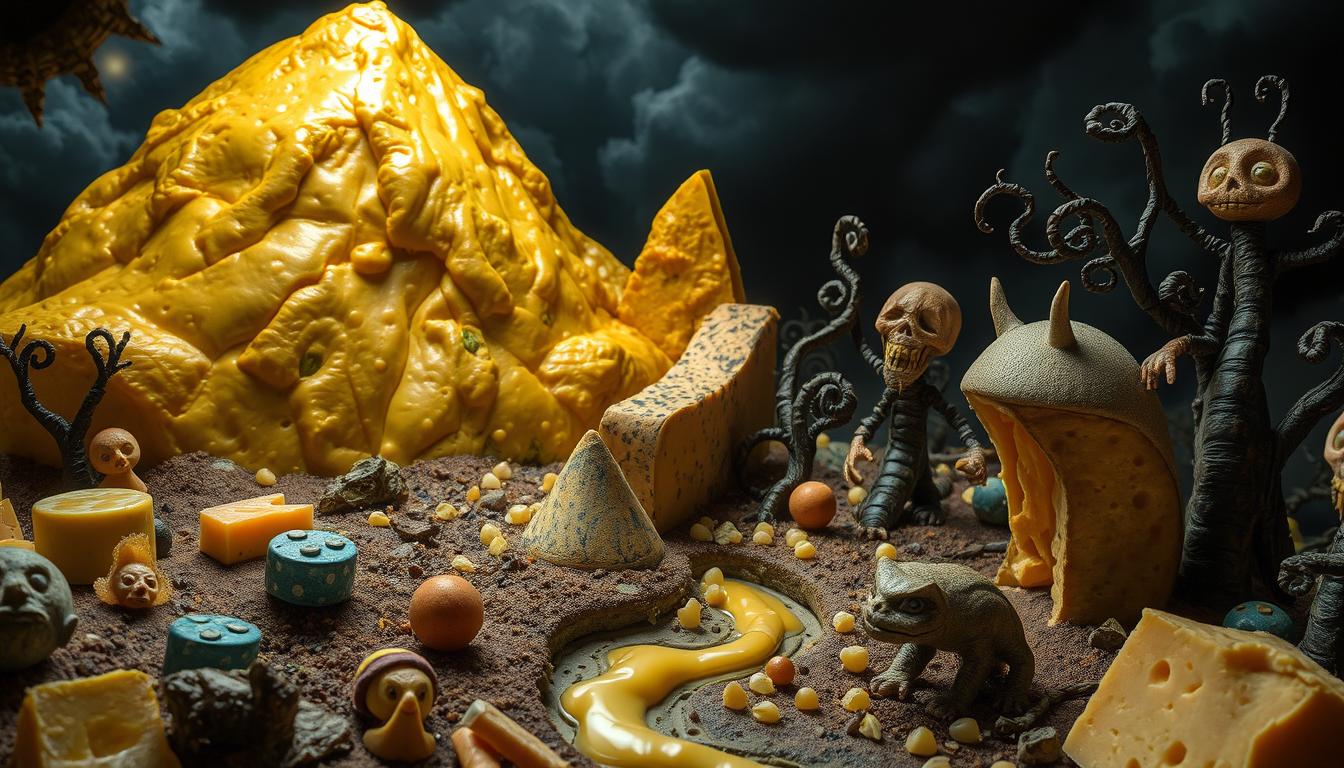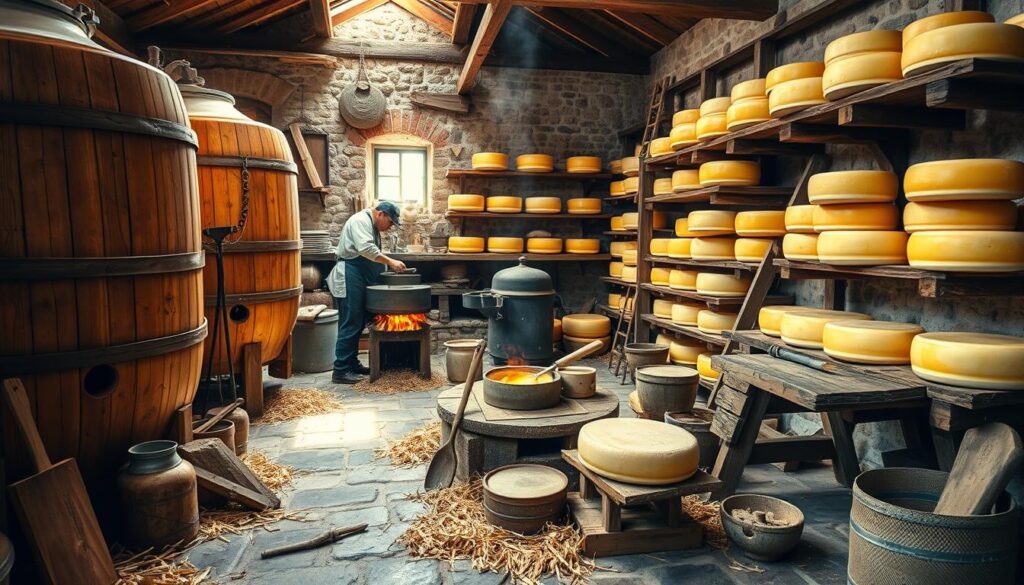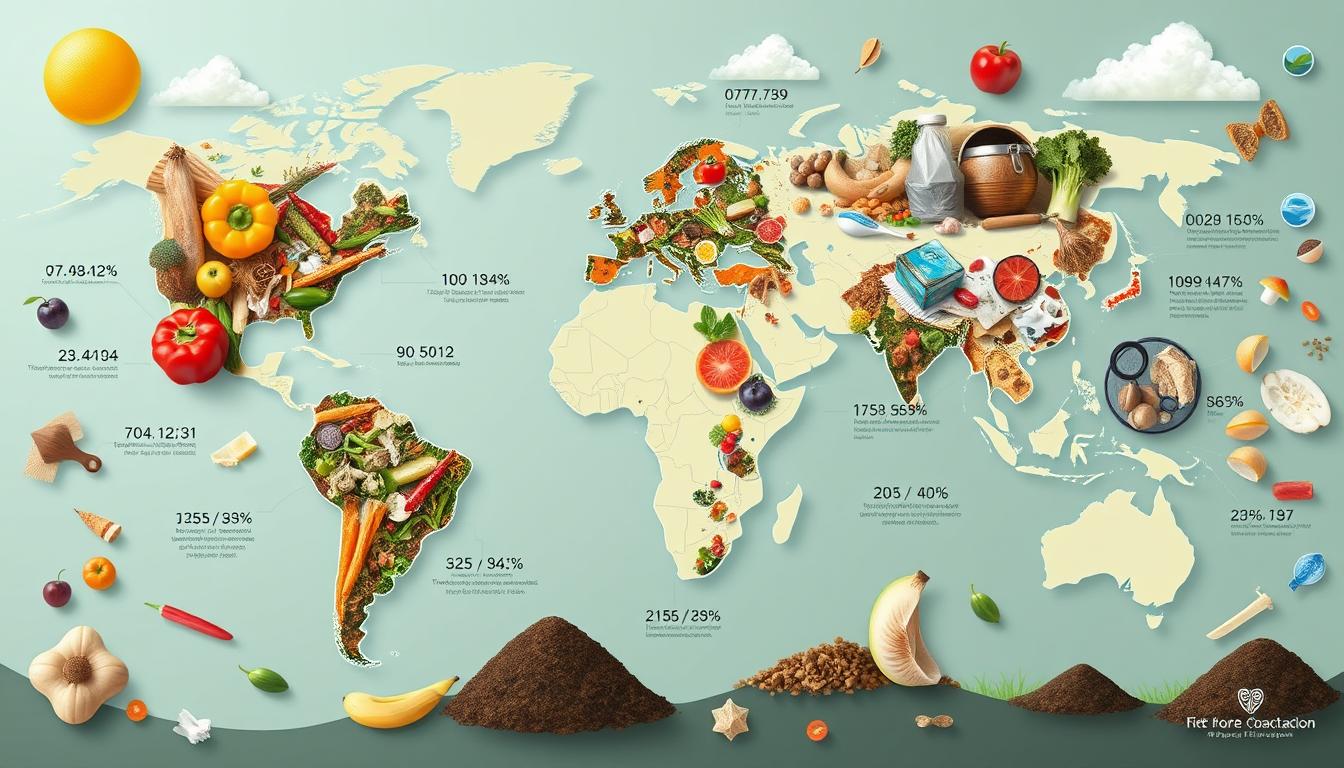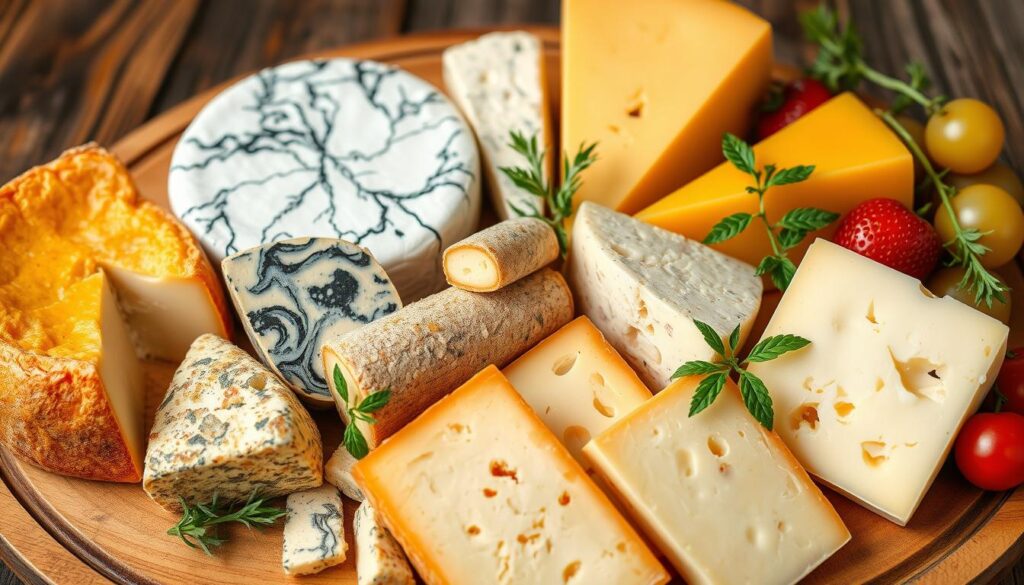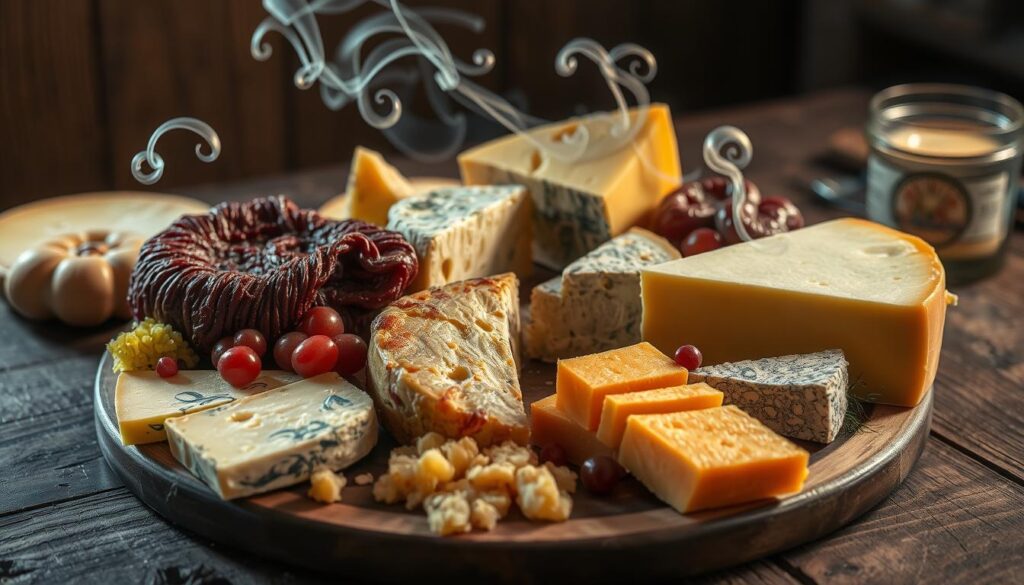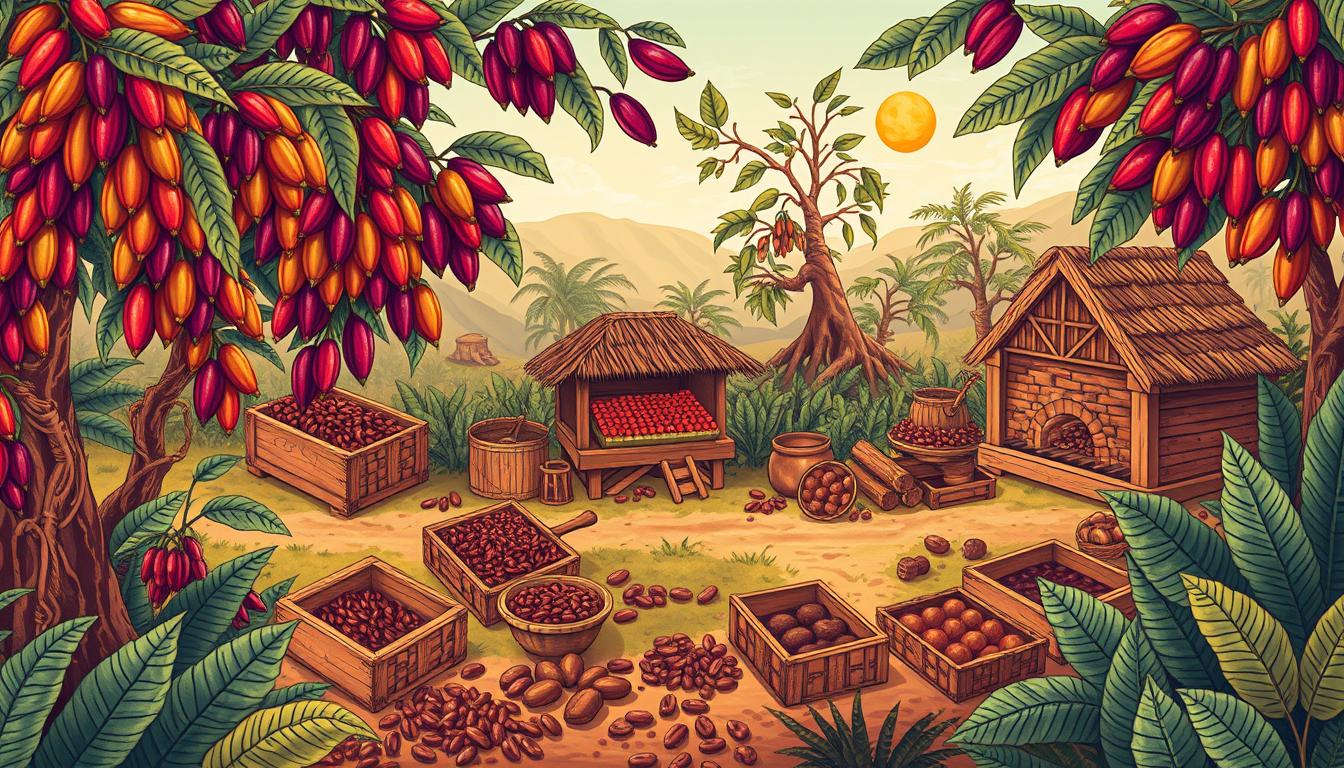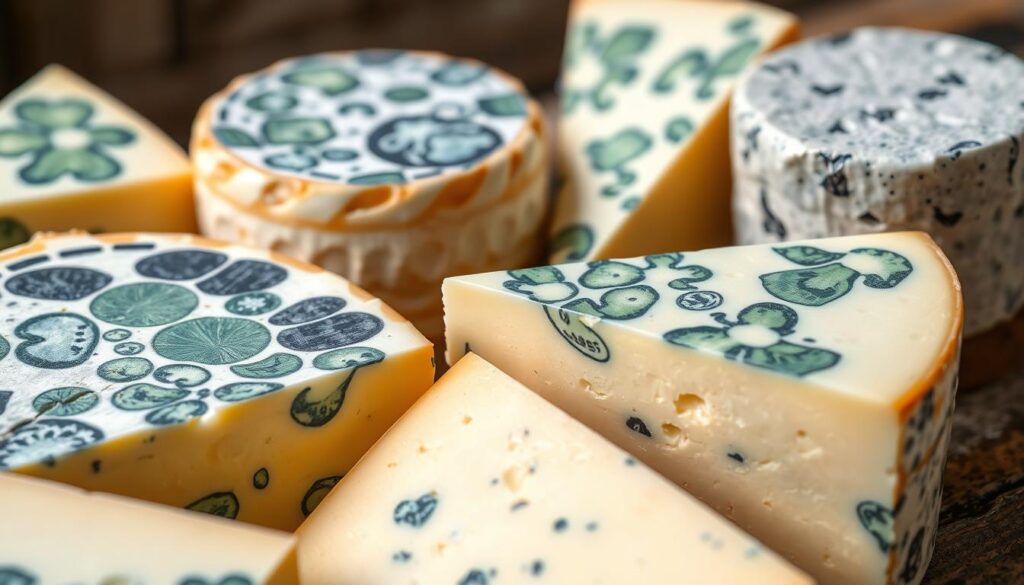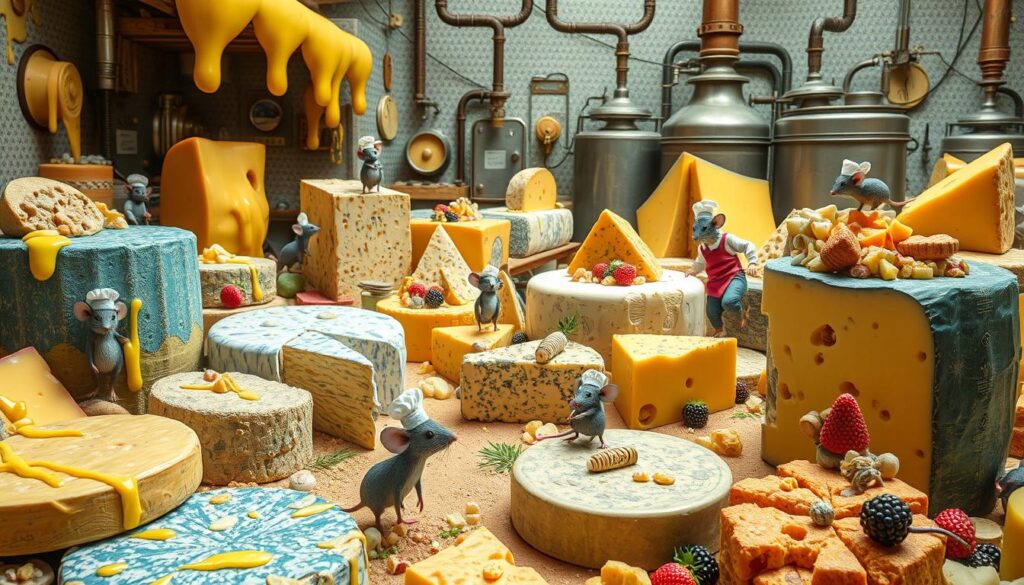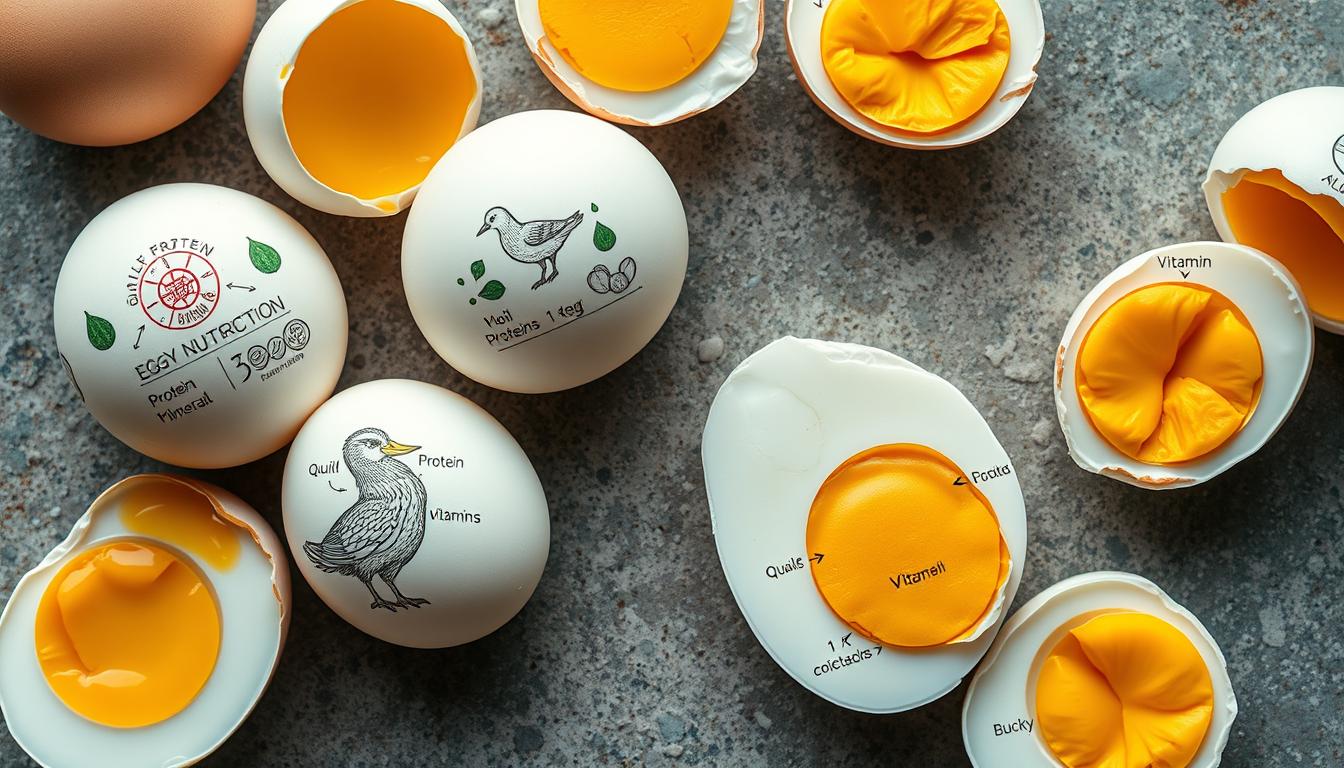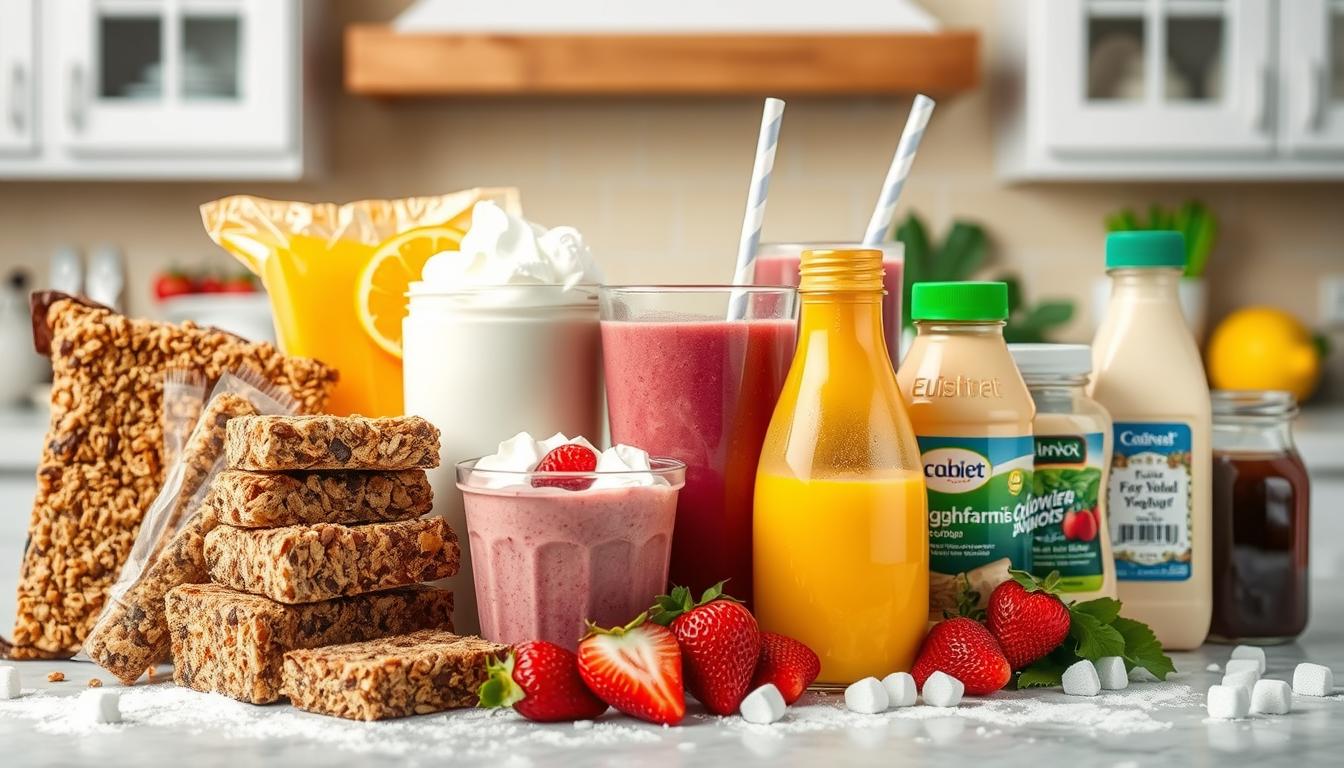Did you know there are over 1,800 types of cheese worldwide? Each has its own taste and making process. From Limburger’s strong smell to Brie’s creamy feel, cheese is loved in many dishes. But, there’s a lot more to cheese than meets the eye, with a history full of surprising and sometimes gross facts.
Cheese has been around for thousands of years, starting in Mesopotamia around 6000 BC. Making cheese involves microbes like bacteria and mold, which add to its taste. Some microbes, like Brevibacterium linens, make certain cheeses smell like smelly feet.
The world of cheese is full of secrets and surprising facts. From using animal rennet to the presence of maggots in some cheeses, the industry has its gross side. Even cheddar’s orange color comes from a dye, not nature.
Key Takeaways
- Cheese has a long and fascinating history dating back to ancient civilizations.
- Microbes like bacteria, mold, and fungi are essential in giving cheese its unique flavors.
- Some cheese production practices may be considered gross or shocking to consumers.
- The FDA has banned certain cheeses in the U.S. due to safety concerns.
- Processed cheese products are not 100% cheese and contain additives and preservatives.
Table of Contents
- 1 The History of Cheese: Not So Appetizing Origins
- 2 Cheese by the Numbers: Shocking Statistics
- 3 The Science of Stink: Why Cheese Smells Like Smelly Feet
- 4 Cheese Is Teeming with Mold and Bacteria: When Fungus is Intentional
- 5 Gross Facts About Cheese Production
- 6 The Deceptive Color of Cheddar Cheese
- 7 FDA Banned Cheeses in the United States
- 8 Processed Cheese: Not Entirely Cheese
- 9 Cheese Aged in Caves: A Historical Tradition
- 10 The Mystery of Swiss Cheese Holes Solved
- 11 Not All Cheese Is Vegetarian-Friendly
- 12 The World’s Most Expensive Cheese: Pule from Serbian Donkey Milk
- 13 The Addiction Factor: Cheese as “Dairy Crack”
- 14 Queen Victoria’s Unusual Wedding Present: A Giant Wheel of Cheddar
- 15 Cheese Consumption and Tooth Decay Prevention
- 16 Amino Acid Tryptophan in Cheese May Improve Sleep Quality
- 17 Naturally Aged Cheese: A Better Option for Lactose-Intolerant Individuals
- 18 Source Links
The History of Cheese: Not So Appetizing Origins
The history of cheese is quite fascinating, dating back around 7,000 B.C. in Southwest Asia. It’s believed that cheese was first made accidentally. This happened when milk was stored in animal stomachs, causing it to curdle.
Ancient Cheese-Making Techniques
Back then, making cheese involved using animal rennet. This enzyme comes from the stomachs of young calves. It helps milk turn into cheese. Nomadic tribes in the Middle East started making cheese in large wheels about 8,000 years ago. This method was easy to transport and lasted through history.
In the last 50 years, cheese-making has become more regulated for hygiene. Yet, some artisanal cheeses are made the old way, using animal rennet.
Accidental Discovery Using Animal Stomachs
The discovery of cheese was likely an accident. It happened when milk was stored in animal stomachs. The rennet in the stomach lining made the milk curdle, creating cheese.
This happy accident started the journey of cheese-making. It led to many cheese types, from bries and parmesans in old paintings to the famous Parmigiano Reggiano from the 12th century.
| Cheese Variety | Origin | Production Method |
|---|---|---|
| Parmigiano Reggiano | Italy | Hard paste, aged 12-30+ years |
| Cheddar | England | Packaged in wheels, 17th century |
| Processed Cheese | United States | Developed in 1911, mass-produced |
Over time, cheese-making changed from a monastic and rural activity to a large-scale industry in the 19th century. Today, cheese is a key part of many cuisines around the world. Its rich history and varied production methods fascinate both food lovers and historians.
,,
Cheese by the Numbers: Shocking Statistics
Cheese is loved by millions around the globe. But the global cheese production and consumption numbers might amaze you. The United States leads in cheese production, with Wisconsin and California at the forefront. The U.S. produces an incredible 11.8 billion pounds of cheese every year.
Greece and France top the list for cheese consumption, with 27.3 and 24.0 kilograms per person in 2003, respectively. Yet, the average American consumes an impressive 33 pounds of cheese annually. Cheese consumption in the U.S. has tripled from 1970 and keeps growing.
The world of cheese is vast, with Britain alone having about 700 local cheeses. France and Italy have around 400 each. From Limburger cheese in Wisconsin to moose cheese in Sweden, which costs about US$1000 per kilogram, the variety is incredible.
The Dark Side of Cheese Consumption
Cheese is a favorite, but it comes with health risks. It’s the No. 1 source of saturated fat in the American diet. It can raise cholesterol and increase heart disease and Alzheimer’s risk. The U.S. government gets about $140 million a year from the cheese industry to promote it. This might contribute to higher cheese consumption and cholesterol levels in Americans.
The cheese statistics show a complex view of a food we all love. While cheese variety and production grow, we must consider its health effects. Excessive cheese consumption can have serious health impacts.
The Science of Stink: Why Cheese Smells Like Smelly Feet
Ever wondered why some cheeses smell like smelly feet? It’s because of a special bacteria called Brevibacterium linens. This bacterium makes certain cheeses smell strong and is also found in human body odor, like foot smell.
Bacteria Responsible for Cheese Odors
Many bacteria help make cheese unique. Researchers from Tufts University tested 16 cheese bacteria with five fungi to see how they grow together. They found that the bacteria’s growth changes due to the fungi’s smells.
Some cheeses, like Vieux Boulogne and Époisses de Bourgogne, have strong smells. Vieux Boulogne gets its smell from being brushed with beer during aging. Époisses de Bourgogne is so smelly, it’s banned on French public transport.
The Stinky Cheese Connection: Brevibacterium Linens
Brevibacterium linens is key in making stinky cheeses like Limburger. It’s also found in human body odor, mainly in feet. This connection might seem strange, but it’s part of how cheese is made.
A French study found 11.5% of 332 people were really disgusted by stinky cheese. Over half of those who were disgusted said they didn’t like cheese much. Disgust can be influenced by emotions, social factors, and chemical reactions.
| Cheese | Bacteria | Aroma Characteristics |
|---|---|---|
| Limburger | Brevibacterium linens | Strong, pungent, foot-like odor |
| Époisses de Bourgogne | Brevibacterium linens, others | Intense, stinky aroma; banned from public transport in France |
| Vieux Boulogne | Various, rind washed with beer | Stinky, beer-influenced aroma |
Cheese Is Teeming with Mold and Bacteria: When Fungus is Intentional
Cheese is made with mold and bacteria on purpose. These add to its taste and texture. Though it might seem odd, these molds are safe and key to making cheese.
Fungi, like mushrooms, are big in food production. They’ve grown more popular as people want them more.
Types of Mold Used in Cheese Production
There are different molds for different cheeses. For example, Penicillium roqueforti makes blue cheese’s blue-green veins. Penicillium camemberti gives Camembert and Brie their white, fluffy rinds. These molds are chosen for their special effects on cheese.
Pseudoalteromonas: The Marine Bacteria Found in Cheese
Pseudoalteromonas is a marine bacteria in cheese. It makes many flavors. It’s been around for about 3.5 billion years, making it very old.
Penicillium: The Mold That Gives Blue Cheese Its Distinctive Flavor
Penicillium mold is key for blue cheese. It grows inside, making the cheese blue-green and tangy. But, it can also make mycotoxins, which are harmful.
| Cheese Type | Mold/Bacteria | Characteristic |
|---|---|---|
| Blue Cheese | Penicillium roqueforti | Blue-green veins, sharp flavor |
| Camembert | Penicillium camemberti | White, fluffy rind |
| Various Cheeses | Pseudoalteromonas | Unique flavor compounds |
Safety of Consuming Moldy Cheeses
Eating moldy cheese might seem scary, but the molds used are safe. They’re picked and watched to avoid toxins. But, not all mold on cheese is safe. Always throw away cheese with unwanted mold.
Knowing about mold and bacteria in cheese makes it more interesting. When buying cheese, choose types with these beneficial microbes, like blue cheese, for a safe and unique taste.
Gross Facts About Cheese Production
While cheese is loved by many, its making can be quite surprising. From animal rennet to maggot cheese, cheese production has its weird side.
The Use of Animal Rennet in Cheese-Making
Traditional cheeses often use animal rennet, an enzyme from unweaned calves’ stomachs. This might shock some people. Yet, many cheeses are made with it, and there are also vegetarian options.
Maggot-Infested Cheese Varieties
In Sardinia and Corsica, there’s a cheese called casu marzu with live maggots. It’s a favorite among some, despite the maggots. The maggots break down the cheese, making it soft and creamy.
Cheese Made from Unconventional Milk Sources
Cheese is usually made from cow, goat, or sheep milk. But, some cheeses come from donkey milk. Pule, the world’s priciest cheese, is made from Serbian donkey milk. It shows the variety in cheese-making.
These facts might shock you, but they show the wide range of cheese-making. With over 20 million metric tons made yearly, cheese is always surprising us.
The Deceptive Color of Cheddar Cheese
Cheddar cheese is not naturally orange. It’s actually white or light yellowish, thanks to beta carotene. So, why does most cheddar cheese look orange? It’s because of a long tradition and a bit of food coloring.
Annatto: The Natural Dye Used to Color Cheddar
In the 17th century, English cheesemakers started adding coloring agents like annatto to their cheese. They used annatto, saffron, marigold, or carrot juice to get the yellowish-orange color of higher-fat cheese. Today, annatto is the main coloring agent in cheddar cheese production.
Beta-Carotene: Why British Cheddar Has a Natural Orange Tint
British cheddars get their orange color from annatto, but some have a natural yellowish-orange tint. This is because cows like Jersey and Guernsey have milk rich in beta-carotene. The artisanal food movement has also led to cheeses from grass-fed cows, giving them a buttery color like 17th-century Londoners enjoyed.
| Coloring Agent | Source | Used in Cheddar |
|---|---|---|
| Annatto | Achiote tree seeds | Yes |
| Beta-Carotene | Cow’s diet (grass) | Yes (naturally) |
| Saffron | Crocus flower stigmas | Historically |
| Marigold | Marigold flower petals | Historically |
| Carrot Juice | Carrots | Historically |
In the U.S., states like Indiana, Ohio, Wisconsin, and New York often add color to cheddar cheese for marketing. But, New England dairy farms have always preferred naturally white cheddar.
Coloring food isn’t just for cheddar cheese. Many foods, like tuna, pickles, oranges, wasabi, dried apricots, pickled ginger, and farmed salmon, are colored to look better and meet consumer expectations.
FDA Banned Cheeses in the United States
The FDA has strict rules on certain cheeses in the U.S. This includes cheeses made from raw milk and aged for less than 60 days. Cheeses like Brie de Meaux, Sainte-Maure-de-Touraine, and Queijo da Canastra are banned due to food safety risks like E. coli or Listeria. This ban has hurt many small businesses and artisan cheese makers across the country.
Artisan cheesemakers in the U.S. have used traditional methods, including wood aging, for over 30-40 years. The FDA’s rules on wood boards in aging cheese have also affected imported cheeses from Canada and the European Union.
Some banned cheeses include Mont d’Or, or Vacherin du Haut-Doubs, a seasonal alpine cheese. It’s made only between August 15 and March 15 and sold in the fall through spring. French Vacherin du Haut-Doubs is banned in the U.S. because of French laws. Swiss Vacherin Mont d’Or, made with pasteurized milk, is available but expensive.
Age-old methods of making cheeses like young, raw Epoisses, Camembert, Tomme de Savoie, and Morbier are also banned in the U.S.
| Banned Cheese | Country of Origin | Reason for Ban |
|---|---|---|
| Brie de Meaux | France | Raw milk, aged less than 60 days |
| Sainte-Maure-de-Touraine | France | Raw milk, aged less than 60 days |
| Queijo da Canastra | Brazil | Raw milk, aged less than 60 days |
| French Vacherin du Haut-Doubs | France | Unpasteurized milk |
| Young, raw Epoisses | France | Unpasteurized milk |
| Young, raw Camembert | France | Unpasteurized milk |
Despite research from the Wisconsin Center for Dairy Research, the FDA’s rules on cheese aging remain strict. In 2014, the FDA lowered the cap on non-toxigenic bacteria in cheeses. This led to more import bans and challenges for domestic raw cheeses.
Processed Cheese: Not Entirely Cheese
When you grab a slice of processed cheese like American cheese or Cheez Whiz, you might be surprised. It’s not 100% cheese. Real cheese must have at least 51% natural cheese to be called cheese. Processed cheese, on the other hand, has about 50% cheese.
Manufacturers mix cheese with emulsifiers, preservatives, salt, food dyes, and other ingredients. This creates a processed cheese product.
In the U.S., there are five types of processed cheese products. These include pasteurized processed cheese, pasteurized blended cheese, and more. Each type has a different minimum actual cheese content, ranging from 51% to 47%.
Emulsifiers, Preservatives, and Food Dyes in Processed Cheese
Processed cheese has ingredients like calcium phosphate and sodium citrate. These additives help make the cheese smooth and extend its shelf life. But, processed cheese also has high sodium and trans fats. These can increase heart disease and stroke risks.
Some processed cheeses, like Pasturized Process American Slices, are made with vegetable oil. They try to mimic real American cheese but often don’t succeed. Brands like La Vache Qui Rit use real cheeses like Comté and Emmental. This results in fewer additives and preservatives than most processed cheeses.
The Longevity and Versatility of Processed Cheese Products
Processed cheese may not be as nutritious as real cheese. Real cheese offers calcium, niacin, and vitamins A and B12. But, processed cheese lasts longer and can be made into various forms.
The invention of processed cheese dates back to 1916. James Kraft patented the technique for creating American cheese in the US. This cheese was known for its long shelf life and easy shipping. Today, processed cheese products are common in many households. Brands like La Vache Qui Rit have grown to over 100 countries on five continents in nearly 100 years.
| Cheese Type | Minimum Cheese Content | Characteristics |
|---|---|---|
| Real Cheese | 51% | Varied textures and melting points, wide range of flavors, nutritional benefits |
| Processed Cheese | 50% | Mild flavor, silky texture, contains additives and preservatives, longer shelf life |
Cheese Aged in Caves: A Historical Tradition
Cheese aged in caves has a long history, dating back thousands of years. It started because people needed to keep cheese without refrigeration. Natural caves were perfect for aging cheese, with their cool temperatures and high humidity.
In France, Switzerland, and Italy, caves have been used for centuries. They age famous cheeses like Roquefort, Gruyère, and Parmigiano Reggiano.
Today, many cheesemakers keep this tradition alive. They use natural caves or special “cheese caves” with modern technology. Caputo’s Market & Deli in Utah has two cheese caves, one opened in 2009 and the other in 2015.
In the U.S., not all cheeses need caves for aging. But blue cheese, aged cheddar, and Gruyère do. Just 1,500 tonnes of Ford Farm’s Cheddar is made each year in England. This is a small part of all Cheddar made.
These Cheddar truckles must age for at least nine months. This is to meet the Protected Designation of Origin (PDO) status.
| Cheese | Aging Process |
|---|---|
| Roquefort | Aged in natural caves in France for 3-6 months |
| Gruyère | Aged in natural caves in Switzerland for 6-12 months |
| Parmigiano Reggiano | Aged in natural caves in Italy for 12-36 months |
| Revived Taleggio D.O.P. | Spends 3 weeks in Caputo’s cheese caves for rehabilitative care |
| Ford Farm Cheddar | Aged for 9 months at Ford Farm, with some aging an additional 6 months in caves |
Cheese lovers can visit famous caves like the Roquefort Caves in France. They can also go to Neal’s Yard Dairy in the UK and Point Reyes Farmstead Cheese Company in the U.S. for tours and tastings. These visits give a peek into the traditional cheese aging process and the unique flavors and textures of cave-aged cheese.
The Mystery of Swiss Cheese Holes Solved
The holes in Swiss cheese, like Emmental or Appenzeller, have always fascinated people. In 2015, scientists found out why these holes form. They discovered that hay dust is the main reason.
Hay Dust: The Surprising Cause of Holes in Swiss Cheese
Researchers added hay dust to milk and watched for 130 days. They found that hay particles create weak spots in the cheese. This lets carbon dioxide bubbles form, making the holes.
William Mansfield Clark solved the mystery in 1912. He said specific bacteria in the cheese-making process cause the holes.
Modern Milking Practices and the Disappearance of Cheese Holes
Modern milking is cleaner, so there’s less hay dust in milk. This means fewer holes in Swiss cheese. In the 1990s, European cheesemakers noticed fewer holes due to cleaner milking.
Swiss cheese comes in three grades: A, B, and C. Each has rules for hole size and shape. Grade A has the biggest and most uniform holes.
| Swiss Cheese Grade | Eye Size | Characteristics |
|---|---|---|
| Grade A | 3/8 to 13/16 inch | Uniform eye size and distribution |
| Grade B | Varies | Less uniform eye size and distribution |
| Grade C | Varies | Various eye characteristics to a slight or definite degree |
Now, cheesemakers can control hole size by adding particles to milk. Adding hay can help make Swiss cheese with more holes.
Understanding Swiss cheese holes has helped cheesemakers. It lets them make cheese with the look we love.
Not All Cheese Is Vegetarian-Friendly
Not all cheese is good for vegetarians because some use animal rennet. This enzyme comes from the stomachs of young calves. It helps turn milk into cheese. Cheeses like Parmesan and Gorgonzola often have animal rennet, making them not vegetarian.
But, many cheeses are now made with vegetarian rennet. This can be from plants or special bacteria. Cheeses like cottage cheese and mozzarella are usually safe for vegetarians.
The demand for vegetarian cheese has grown. This is because of less veal and more expensive animal rennet. Lab-created and microbial rennet have become popular, making more cheese options available.
Even so, about 20-25% of cheeses might use animal rennet. Brands like Cabot clearly say they use no animal rennet. Websites like JoyousLiving.com help find vegetarian cheese brands.
Vegan cheese is made without milk, using things like cashews and soy. Soy and rice cheeses are also great for those who want plant-based cheese.
Always check labels for “vegetarian-friendly” to make sure the cheese fits your diet and values.
The World’s Most Expensive Cheese: Pule from Serbian Donkey Milk
Pule, a rare cheese from Serbia, is the world’s priciest. It can cost over $600 per pound. This is much more than the average price of cheddar cheese in the U.S., which was $5.26 per pound in December 2021. Sometimes, Pule cheese can even cost hundreds or thousands of dollars per pound.
The high price of Pule cheese comes from the rare milk and hard production process. Balkan donkeys, the main milk source, produce very little milk. Each of the 20 milking jennies gives less than 5L of milk a day, unlike cows that can give up to 60L. Serbian donkeys only give two liters at most, making milk for Pule cheese very scarce.
Farmers must hand-milk the jennies three times a day to get the best milk. Because donkey milk lacks casein, Pule cheese is made with 60% donkey milk and 40% goat milk. It takes 25L (6.6 gallons) of milk to make just 1kg of Pule cheese, much more than most cheeses.
Making Pule cheese requires skill, tradition, and precision. After making, the cheese spends up to 3 days in mould and then a month in a maturation room. It ages for several months or longer, giving it a rich, creamy taste and pale yellow color.
Zasavica, the Serbian nature reserve, is home to nearly 200 donkeys. Even with limited supply, you can try Pule cheese at specialty shops or online. For those wanting to make traditional Norwegian krumkake cookies, a good krumkake maker is essential for home baking.
| Cheese Type | Price per Pound | Milk Source | Production Location |
|---|---|---|---|
| Pule | $600 – $1,700 | 60% Donkey Milk, 40% Goat Milk | Zasavica, Serbia |
| Cheddar (U.S. Average) | $5.26 | Cow Milk | Various locations in the U.S. |
The Addiction Factor: Cheese as “Dairy Crack”
Ever craved cheese and couldn’t stop? You’re not alone. Cheese is called “dairy crack” because it has chemicals called casomorphins. These can make you feel like an addict.
Chemical Compounds in Cheese Affecting the Brain
Casomorphins come from casein, a milk protein found in cheese. When we digest cheese, these compounds are released. Research in France and Poland shows they can reach our brains, affecting our mood and actions.
Cheese also has other chemicals like phenylethylamine (PEA), similar to amphetamines. It has hormones too, whose roles we don’t fully understand. Americans eat about 33 pounds of cheese each year. This high intake might make cheese even more addictive.
Comparison to Addictive Substances
Cheese’s addictive qualities are like those of opiates. A 1981 study found morphine in cow’s milk. Cheese’s processing makes it even more concentrated with casomorphins, giving a feel-good sensation like opiates.
The European Food Safety Authority looked into casomorphins in 2009. But their findings were mixed. Cheese’s addictive nature, along with its fat and cholesterol, worries health experts. Unhealthy diets and lack of exercise kill 300,000 to 500,000 Americans each year.
Queen Victoria’s Unusual Wedding Present: A Giant Wheel of Cheddar
When Queen Victoria married Prince Albert in 1840, she got a unique gift: a huge wheel of cheddar cheese. This massive cheese was over nine feet around and 20 inches deep, weighing a whopping 1,000 pounds. For comparison, a normal cheddar wheel is much smaller, weighing between 60 and 75 pounds.
This special gift shows how important cheddar cheese is in British culture and history. Cheddar, made from cow’s milk, has been around in England for over 800 years. It’s a favorite in the UK.
Making this giant cheddar wheel was a big job for the cheesemakers. They use a special method called “cheddaring” to make it firm. Creating such a huge wheel took a lot of time, skill, and resources.
| Characteristic | Queen Victoria’s Cheddar Wheel | Typical Cheddar Wheel |
|---|---|---|
| Circumference | Over 9 feet | – |
| Depth | 20 inches | – |
| Weight | 1,000 pounds | 60-75 pounds |
The giant cheddar wheel’s fate is a mystery, but it highlights cheddar’s lasting appeal in British culture. Today, the US is the world’s biggest cheese maker. But the UK keeps its cheesemaking traditions alive, with cheddar being a beloved choice.
Cheese Consumption and Tooth Decay Prevention
Cheese is packed with calcium, fat, protein, vitamins A and B12, zinc, phosphorus, and riboflavin. It might help prevent tooth decay. A study in the General Dentistry journal in spring 2013 looked at dental health and diet in 12 to 15-year-olds.
The study checked pH levels before and after eating milk, cheese, and sugar-free yogurt. It found that keeping pH levels above 5.5 can lower tooth cavity risk. Dairy products, like cheese, didn’t change pH levels, but they might help prevent cavities.
Experts say we should eat two dairy servings a day, three for older adults, and three to four for teens. A serving is like one cup of milk, ¾ cup of yogurt, or 1.5 ounces of cheese. Dairy is good for teeth and bones, and also for muscles and cell growth.
| Nutrient | Benefit |
|---|---|
| Calcium | Strengthens teeth and bones |
| Protein | Muscle tissue repair |
| Vitamin A | Cell growth and oral health |
| Potassium | Reduces bone loss |
Dairy’s lactic acid can kill bacteria that cause decay. But, remember, eating dairy is just part of good oral care. Brushing, flossing, and dental visits are also key. Adding cheese and other dairy to your diet can help keep your teeth healthy if you also take care of your mouth.
Amino Acid Tryptophan in Cheese May Improve Sleep Quality
Looking for a natural way to better sleep? Cheese might be the answer. It has tryptophan, which helps improve sleep. Adults need 250 mg to 425 mg of tryptophan daily, or 3.5 to 6.0 mg per kilogram of body weight.
A study by the British Cheese Board found that cheese before bed can help sleep. It’s because cheese has lots of tryptophan. A study on US college students showed that eating dairy before bed can lead to better sleep.
Japanese elite athletes in another study found that milk and dairy can improve sleep. This was true for women and men, but more so for women. Cheeses like Cheddar have a tryptophan ratio similar to turkey and chicken.
Tryptophan is key for making coenzymes NAD and NADP in all cells. Only 3% of tryptophan is used for serotonin in the body, and 1% in the brain. Melatonin, made from tryptophan, helps control sleep patterns.
A study on Japanese adults aged 65 or older found that more milk intake means better sleep. Swedish older adults also had better sleep with more milk and dairy.
Remember, cheese is good for sleep but eat it in moderation. A UK study showed that too much or too little milk can disrupt sleep.
Adding cheese to your diet for better sleep? Try these high-protein waffle recipes without yogurt for a tasty breakfast or snack.
| Cheese Type | Tryptophan Content (mg/100g) |
|---|---|
| Cheddar | 390 |
| Parmesan | 410 |
| Swiss | 360 |
| Mozzarella | 290 |
Note: In response to the eosinophilia-myalgia syndrome (EMS) outbreak linked to synthetic tryptophan consumption in the late 1980s, the United States FDA placed a ban on over-the-counter tryptophan supplements until it was lifted in 2001.
Naturally Aged Cheese: A Better Option for Lactose-Intolerant Individuals
If you have lactose intolerance, naturally aged cheeses like Parmigiano-Reggiano might help. They have less than 1 mg of lactose per 100 grams. The cheese-making process removes most lactase, making aged cheeses lower in lactose.
Hard cheeses like cheddar, mozzarella, and Monterey Jack also have less lactose. They have less than one gram of lactose per 1.5 ounce serving.
Other cheeses with less lactose include feta, goat cheese, cottage cheese, and Swiss cheese. They have only about 0.01% lactose. These cheeses are easier to digest for those with lactose intolerance. They go through fermentation, breaking down lactose.
The NIDDK says people with lactase non-persistence can eat several servings of low-lactose dairy daily.
Even though cutting down on dairy might mean missing out on some nutrients, aged and low-lactose cheeses are good sources of protein and calcium. To manage lactose intolerance, eating small amounts of low-lactose dairy over time is advised. It’s also wise to talk to a doctor to confirm the severity of your lactose intolerance.
Source Links
- What Cheesemakers Don’t Want You To Know – Mashed – https://www.mashed.com/1536114/what-cheesemakers-dont-want-you-to-know/
- There’s A Science Behind Why Cheese Is Created In Wheels – Chowhound – https://www.chowhound.com/1569811/science-behind-cheese-created-in-wheel-form/
- On the Culinary and Artistic History of Cheese – https://lithub.com/on-the-culinary-and-artistic-history-of-cheese/
- Parmigiano Reggiano: History, Info, Interesting Facts – WFC – https://webfoodculture.com/parmigiano-reggiano-history-info-interesting-facts/
- Top 10 Fascinating Facts About Cheese – Listverse – https://listverse.com/2009/09/18/top-10-fascinating-facts-about-cheese/
- Five Frightful Facts About Cheese – https://www.pcrm.org/news/blog/five-frightful-facts-about-cheese
- Why Are Some Cheeses Stinky? – https://wonderopolis.org/wonder/why-are-some-cheeses-stinky
- ‘Cheese stink’ is actually microbes ‘talking’ to each other, a critical function for flavor – https://studyfinds.org/cheese-stink-microbes-communicate/
- What Stinky Cheese Tells Us About the Science of Disgust – https://www.smithsonianmag.com/science-nature/what-stinky-cheese-tells-us-about-disgust-180965017/
- The Role of Fungi in Food Production and Processing – https://www.mdpi.com/2076-3417/14/12/5046
- Beyond your level of vision exists a microbial world teeming with life – https://pbge.faculty.ucdavis.edu/wp-content/uploads/sites/408/2016/10/Microbe-Laboratories.pdf
- 9 Gross Facts About Cheese for #Februdairy – https://www.peta.org.uk/blog/9-gross-facts-cheese-februdairy/
- 21 Crazy Facts About Cheese! – Learn About Cheese At Shisler’s! – https://www.cheesehouse.com/uncategorized/mind-blowing-cheese-facts/
- 8 Foods You’d Never Guess Were Artificially Colored – https://www.treehugger.com/foods-youd-never-guess-were-artificially-colored-4863947
- How 17th Century Fraud Gave Rise To Bright Orange Cheese – https://www.npr.org/sections/thesalt/2013/11/07/243733126/how-17th-century-fraud-gave-rise-to-bright-orange-cheese
- FDA May Destroy American Artisan Cheese Industry – https://www.forbes.com/sites/gregorymcneal/2014/06/09/fda-may-destroy-american-artisan-cheese-industry/
- Inside the World of Black Market Cheese – https://www.vogue.com/article/black-market-cheese-america
- Here’s The True Difference Between Processed Cheese And Real Cheese – Mashed – https://www.mashed.com/1296401/difference-between-processed-cheese-real-cheese/
- What Is American Cheese, Anyway? – https://www.seriouseats.com/whats-really-in-american-cheese
- The Laughing Cow – is it REALLY cheese? | Taste of France – https://tasteoffrancemag.com/trending/say-cheese/
- Where Are the Cheese Caves: 5 Fascinating Facts You Didn’t Know – The Cheese Cave – https://cheesecave.net/blog/where-are-the-cheese-caves-5-fascinating-facts-you-didnt-know/
- How Cheeses are Revived, Transformed & Created in the Caves at Caputo’s | The Cheese Professor – https://www.cheeseprofessor.com/blog/caputos-caves
- Troglodytes and Turophiles (or, a Tale of Cave-dwellers and Cheese-lovers) – https://fromagehomage.co.uk/2015/05/19/troglodytes-and-turophiles-or-a-tale-of-cave-dwellers-and-cheese-lovers/
- Holey Cow! Swiss Cheese Mystery Solved – https://blog.education.nationalgeographic.org/2015/05/29/holey-cow-swiss-cheese-mystery-solved/
- Why Does Swiss Cheese Have Holes? – https://www.wonderopolis.org/wonder/why-does-swiss-cheese-have-holes
- Is Cheese Vegetarian? Slicing into the Truth – https://sagealphagal.com/is-cheese-vegetarian/
- Do You Know Which Cheeses Are Vegetarian Friendly? | The Cheese Professor – https://www.cheeseprofessor.com/blog/vegetarian-friendly-cheeses-rennet
- Cheeses – What to watch out for – https://karma-free-cooking.com/topic-index/cheeses-what-to-watch-out-for/
- Pule: World’s Most Expensive Cheese (Origin & Tasting Guide) – https://thecheeseatlas.com/cheese-profiles/pule/
- The World’s Most Expensive Cheese Comes From Balkan Donkey Milk – The Daily Meal – https://www.thedailymeal.com/1158523/the-worlds-most-expensive-cheese-comes-from-balkan-donkey-milk/
- Pule cheese: Unraveling the world’s most expensive cheese – https://www.foxnews.com/world/pule-cheese
- Is Cheese Addictive? – https://bitesizevegan.org/is-cheese-addictive/
- Why Is Cheese So Addicting? – https://sites.psu.edu/siowfa14/2014/12/04/why-is-cheese-so-addicting/
- Cheese! – https://scarhead7.github.io/cheese/cheese.html
- Is Cheese Bad for You? Benefits, Risks, Nutrition Facts – https://www.healthline.com/health/is-cheese-bad-for-you
- How to Prevent Tooth Decay: Consume Dairy Products and Cheese – https://www.biolase.com/blog/may-save-teeth-cavities-dairy-products-cheese/
- Exploring the Role of Dairy Products In Sleep Quality: From Population Studies to Mechanistic Evaluations – https://pmc.ncbi.nlm.nih.gov/articles/PMC10229376/
- L-Tryptophan: Basic Metabolic Functions, Behavioral Research and Therapeutic Indications – https://pmc.ncbi.nlm.nih.gov/articles/PMC2908021/
- Cheeses You Can Eat (Even if You Are Lactose Intolerant) | The Cheese Professor – https://www.cheeseprofessor.com/blog/lactose-intolerance-cheeses
- 9 Delicious Cheeses You Can Eat Even If You’re Lactose Intolerant – https://www.markys.com/blog/delicious-cheeses-you-can-eat-if-you-are-lactose-intolerant?srsltid=AfmBOooy82WAU4ZxW0LjxxTWL3IMF0mu7JMtF6Ie6KS0BAaUm7RDL-uz
